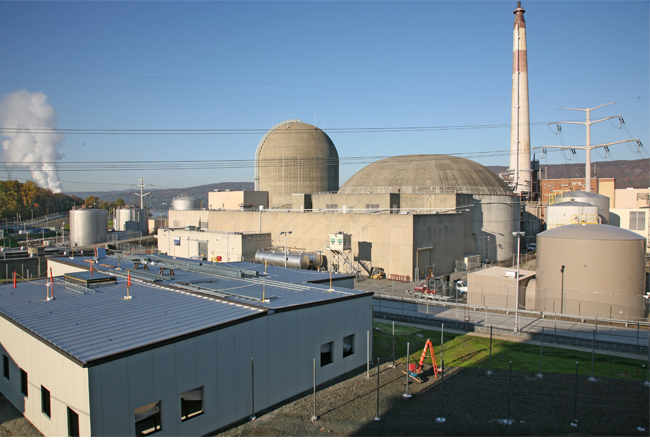State report asks federal agency to review risks from gas pipeline near Indian Point
A group of New York state agencies raised concerns in a report published June 22 about a natural gas pipeline that runs near Indian Point Energy Center.
The agencies released Friday the executive summary of a long-awaited safety assessment of the Algonquin Incremental Market natural gas pipeline, which brings natural gas from Pennsylvania into New England. Its route runs underneath the Hudson River about a quarter mile from the Indian Point nuclear power plant in Buchanan.
The report is a joint effort from the state Division of Homeland Security and Emergency Services and departments of Public Service, Environmental Conservation and Health. The state agencies asked the Federal Energy Regulatory Commission (FERC), which regulates interstate pipelines, to take steps to offset risks associated with the pipeline’s proximity to the nuclear plant. One of those steps is banning further capacity on the pipelines near the plant while Indian Point is still operational.

“While the probability of pipeline incidents is low, the proximity to the Indian Point nuclear plant makes the potential consequences of such an event very significant,” read a joint statement from the state agencies. “Additional scrutiny and monitoring to better understand and reduce risks associated with the Algonquin pipelines is warranted.”
The state’s study reviewed three pipelines in the vicinity of the plant that are each owned by Algonquin Gas Transmission LLC: two 26-inch pipelines that have been in operation for several years and the 42-inch AIM pipeline that was approved in 2015 by FERC. Algonquin Gas Transmission LLC is a subsidiary of Enbridge Inc., a publicly traded company that is Canada’s largest natural gas distribution provider.
The safety assessment from the state’s engineering consultant, HDR Engineering Inc, concludes that risks of a potential pipeline incident are reduced by the upcoming closure of Indian Point”™s nuclear reactors in 2021 and the removal of spent nuclear fuel from the site that the report says will follow.
But, the summary of the report argues, “ongoing public concern in the local communities, and the nature of the critical infrastructure involved,” should prompt further review of the project by FERC.
The state requested that FERC do the following:
– Not approve any additional capacity or increased pressure at the pipelines near Indian Point. The report said high demand for natural gas could lead to Enbridge requesting to send more gas at a higher pressure, which would go beyond what the safety assessments of the original FERC approvals considered.
“The state has remaining questions about the safety assessments of AIM and the original Algonquin pipelines, and it is important to not increase the risk profile of the pipelines while questions remain and Indian Point is still operational,” the state agencies wrote in the letter.
– Conduct regular communications between the pipeline owner and Indian Point owner and operator, Entergy Corp., on incident-prevention activities and emergency preparedness.
– Require regular testing of the pipeline’s capabilities to shut down quickly in the case of an event at Indian Point.
– Coordinate a review of Entergy’s decommissioning plan for Indian Point, once its filed, for any potential impact on the pipelines.
The expanded Algonquin Incremental Market natural gas pipeline runs through New York, Connecticut, Rhode Island and Massachusetts. The nearly billion-dollar project received federal approvals while held by Spectra Energy Partners LP, which Enbridge acquired last year for $28 billion. The plan added 11.1 miles of 42-inch-diameter pipeline and replaced 26.3 miles total along the route.
Amid heavy pressure from local and environmentalist grassroots groups concerned about the safety risks of the pipeline, New York Gov. Andrew M. Cuomo’s administration ordered a safety assessment of the pipeline in February 2016. Activists have since pushed for the report to be released publicly, and it was for the first time Friday.
The state agencies asked FERC to keep the full report confidential, noting it contains sensitive information on the pipelines and nuclear reactor.